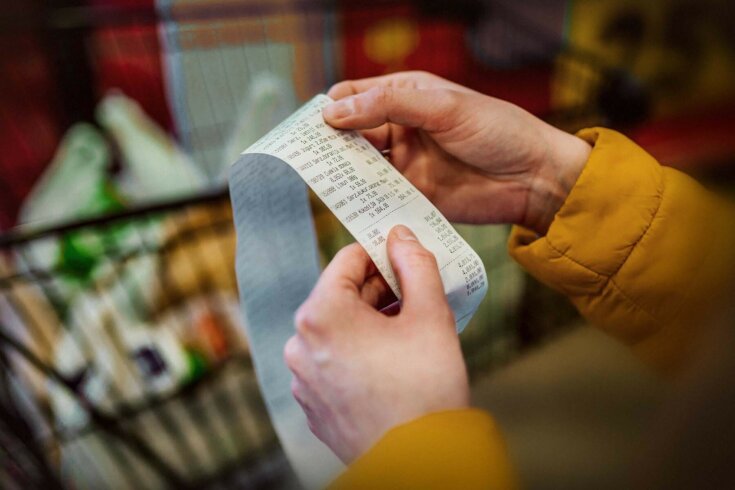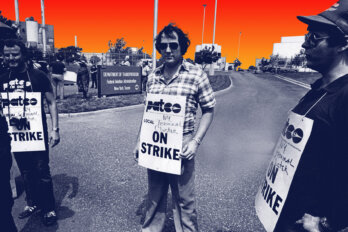After hitting a thirty-one-year high of 6.8 percent last year, Canada’s inflation rates are finally on the decline. But despite cautious optimism from economists, grocery store prices are still going up, with the cost of food rising at a pace double that of regular inflation. Among the items that have seen the sharpest increase, compared to their 2022 prices, are kitchen staples like pasta (nearly 23 percent), lettuce (about 20 percent), butter (just over 19 percent), apples (nearly 17 percent), and fruit juices (close to 16 percent). Millions of Canadians can no longer afford their grocery bill; meanwhile, food bank use is predicted to increase 60 percent this year, according to a recent survey by Second Harvest. We asked Sylvain Charlebois, the director of Dalhousie University’s Agri-Food Analytics Lab and the project lead on Canada’s Food Price Report 2023, to explain what’s behind the sticker shock.
Nicole Schmidt: What are the biggest reasons food price inflation is outpacing overall inflation?
Sylvain Charlebois: The first reason is supply chains. The time it takes to move products from suppliers to grocery stores has gone up because of rising energy costs and labour shortages. It’s like blocking a garden hose. When you play around with it, the water will eventually flow through, but it takes time before the hose gets back to normal. The second factor is climate change. Prices are expected to rise as a result of droughts and other climate catastrophes. California has already been impacted, and so has Spain. Third, Ukraine is a big deal. The country can feed 400 million people with its agriculture during a normal year, so obviously the war has impacted its ability to feed the world.
Food inflation rates vary from one country to another. Take Canada. At 10.3 percent, our rate is actually one of the lowest among the G7 countries, with only the US and Japan ranking lower. According to the Consumer Price Index, food inflation in the European Union has been above 15 percent for a while. A lot of central banks have raised interest rates in an attempt to bring down inflation, and some have been successful to an extent. But unfortunately, interest rates don’t really have a short-term impact on food prices.
NS: When I was in Canada, I spent more money at the grocery store than I do in Germany.
SC: According to a recent poll by global marketing agency Mintel, 83 percent of Canadians believe grocers are mainly to blame for high food prices. As an economist, I can understand why people think that. But our research at the Agri-Food Analytics Lab doesn’t indicate any evidence of greed in retail. Canada is a very challenging market to serve, given the vastness and population density that we have. The Canadian branches of many companies like Sears, Target, and Lowe’s have failed, in part, because of interprovincial barriers. There’s no one Canada; there’s several provinces and territories with different sets of rules, which is very different from the UK, or Germany, or other countries. So that’s one reason why food distribution in Canada is so costly.
NS: Loblaw Q4 profits—and here I mean the company as a whole, not simply the supermarkets—were over $500 million. According to a 2021 report, nearly one in six Canadian households is facing food insecurity. You’re saying it doesn’t seem like grocery stores are playing as big of a role in the price increases as we think they are. But then why are they still turning these big profits?
SC: It’s because of non-food items. When you look at their financial statements, for example, you’ll see that food sales were up 8.4 percent, while food inflation was well above 11 percent during that quarter. This means that Loblaw is treading water with food sales at best. When you look at Shoppers Drug Mart, however, their storefront sales are up almost 12 percent, which means that they’re making money selling prescription drugs and other things, which is how Loblaw is making much of its money.
NS: I read a price comparison of the same products at different grocery stores, and there was almost a $3 difference between peanut butter at Loblaws supermarket versus No Frills and a $7 difference between laundry detergent. But both stores are owned by the same company.
SC: It’s called strategy. I don’t think consumers understand how much influence they themselves have on food prices. Each store deals with a different demographic and a different market, so it makes sense for one to offer a product at a certain price. People say it’s gouging, but to me, it’s not, because customers aren’t forced to buy something at a certain price. They could just go to the other store. And if prices everywhere were to be the same, grocers would likely be accused of collusion, which is something that we don’t want either. So both scenarios are losing scenarios for grocers right now.
NS: Approximately 80 percent of grocery sales in Canada are controlled by the same five chains. Does that at all have an impact on prices and how our grocery store ecosystem functions?
SC: Oh, absolutely. This is a problem in Canada. We haven’t really done a good job of protecting independents. The five players controlling everything right now have too much power, which is why there is talk of establishing a grocer code of conduct. That would lessen the power companies like Loblaw and Walmart have in the market because, right now, they’re squeezing suppliers, and suppliers aren’t giving good deals to independents. That’s why independents are either being bought out or they’re disappearing. In many small towns across the country, you have only one grocery shop left, and when you have only one grocery shop left, guess what happens to food prices? They go up.
NS: A scenario we go back to a lot is the bread price fixing scandal, which revealed that some of Canada’s major grocery stores were, for several years, coordinating price increases. How can we trust these institutions when things like this are going on?
SC: This is the other factor fuelling the hatred toward Loblaw’s CEO Galen Weston. I think Canadians feel unprotected. And this is something I said when I testified in parliament in December as part of the food inflation investigation. If the Competition Bureau goes to a company to ask for data, the company can easily refuse. That wouldn’t happen in the US. It’s just a different regime altogether.
NS: The role of the Competition Bureau is to keep an eye on everything going on to ensure fair play is happening?
SC: Their main role is to assure that the Canadian public is protected, that competition laws are not breached, and that competition is upheld in some way. Whenever there’s a merger or an acquisition, the Competition Bureau is always asked to evaluate, but we have seen major acquisitions in the grocery business in the last twenty to thirty years and nobody seemed to pay much attention until prices became an issue. In 1998, Loblaws bought Provigo in Quebec and nobody blinked an eye. In 2005, Metro bought A&P and nobody said anything. In 2013, Sobeys bought Safeway—nothing. So, in 2018, when Sobeys’ parent company, Empire, bought Farm Boy, we were asked by the bureau to comment. Farm Boy was an independent grocer with twenty-six stores, so we told them we didn’t think Canadians would be impacted but that they need to be careful with independents. Three years later, when Sobeys bought Longo’s—another independent grocery chain—we were asked to comment again, and we said, “Well, that changes our conversation about Farm Boy, doesn’t it?” Because all of a sudden if you have scores of stores being bought out, that’s going to become a problem. You could tell they had no clue what we were talking about.
Look at what’s going on between the Kroger and Albertsons grocery store chains in the US. Congress is actually looking at how consumers in New Haven, Connecticut, are going to be impacted by that merger. The approach is so granular. But it would never happen in Canada right now.
NS: What exactly is at the heart of the difference?
SC: Canada’s Competition Act, which is supposed to encourage equitable opportunity among businesses regardless of their size. The act itself doesn’t really give a whole lot of clout to the Competition Bureau. Meanwhile, the White House will not hesitate to get involved. A couple of years ago, the White House got investigators involved in meat packing to see whether or not there was collusion going on.
NS: And our federal government wouldn’t get involved in the same capacity?
SC: It would never happen right now in Canada—ever.
NS: The increases for food prices this year exceeded the original predictions, and I know you put out predictions for next year. So is it possible that next year’s food price increases could exceed what you predict as well?
SC: I hope not. In 2021, when we released our predictions for 2022, we were expecting increases of 7 percent. At the time, many, many people accused us of being alarmist. We ended out the year at over 10 percent inflation. This year, we estimated 5–7 percent, and nobody’s calling us alarmist anymore—but I certainly hope that I’m wrong.
NS: Another big question: Are food prices doomed to stay this high, or is there a chance we might see them decline in, like, the next year or two?
SC: Highly unlikely. In fact, I recently met with at least thirty-five companies—suppliers, not grocers—and they’re all seeing the same thing. Last year created a new baseline. Commodity prices aren’t necessarily going up, but the cost of everything is. Packaging rules are changing all over the world, and so packaging is actually going to cost way more. Salaries are expected to go up too. Someone has to pay for that.





